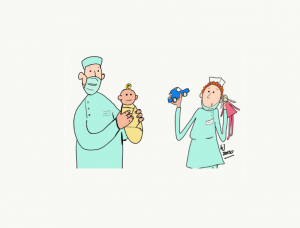
For years we have been told that trans-identified people were born in the wrong body and that it is the clothing, toy and hobby choices of children that mark them out as transgender.
Media-hungry parents have said it of their children, teenage girls with short hair and bound breasts have expressed it on Reddit and Tumblr, and adult men have used to to explain their penchant for sporting lipstick, boobs and high heels.
Yet in the last week there has been a backtrack from lobby groups on this issue. Why might this be?
Well, it could quite possibly have something to do with the newly released ‘relationships, sex and health’ government guidance for schools. In a document titled ‘Plan your relationships, sex and health curriculum‘ under a section entitled ‘Ensuring content is appropriate’ the guidance states the following:
“We are aware that topics involving gender and biological sex can be complex and sensitive matters to navigate. You should not reinforce harmful stereotypes, for instance by suggesting that children might be a different gender based on their personality and interests or the clothes they prefer to wear. Resources used in teaching about this topic must always be age-appropriate and evidence based. Materials which suggest that non-conformity to gender stereotypes should be seen as synonymous with having a different gender identity should not be used and you should not work with external agencies or organisations that produce such material. While teachers should not suggest to a child that their non-compliance with gender stereotypes means that either their personality or their body is wrong and in need of changing, teachers should always seek to treat individual students with sympathy and support.
So it seems that schools must no longer teach children that ‘their body is wrong and need of changing’ or that their choice of clothing toys and hobbies mean they are ‘a different gender’.
Those of us who are aware of the vast increase in children presenting to gender clinics, the concerns of many professionals who work in them, and the increased presence of organisations such as Mermaids and Gendered Intelligence in schools, greeted this news with relief.
“It’s so clever, isn’t it?” Posie Parker told Sonia Poulton on Raw Report on 26th September. “They haven’t said ‘let’s get Mermaids and Stonewall out of schools’, but they’ve basically said, ‘let’s get Mermaids and Stonewall out of schools.”
This is certainly a blow for the ‘trans toolkits’ which have been distributed to schools and followed with zeal in woke areas such as Brighton and many other parts of the country.
Stephanie Davies-Arai of Transgender Trend, who produce an alternative schools guidance, told me:
“We have had a surge in orders for our schools resources since the DfE published their new RSE guidance. Clearly schools will want to ensure their policies outside this specific curriculum area are not in breach of the new guidance so they need to be looking again at any transgender guidance they are currently using.”
 Our schools pack is in fact the only available guidance which is fully compatible with all aspects of the new DfE guidance. All other transgender toolkits and resources promote an ‘affirmation’ approach which suggests to children their bodies are ‘wrong’.
Our schools pack is in fact the only available guidance which is fully compatible with all aspects of the new DfE guidance. All other transgender toolkits and resources promote an ‘affirmation’ approach which suggests to children their bodies are ‘wrong’.
Some suggest a child might want to change their body to ‘match’ their identity, and medical intervention is suggested as casually as changing clothes and pronouns. All advise that a child’s ‘identity’ is real and their biological sex is irrelevant. The DfE has stated unequivocally that resources must be evidence-based so we are expecting a continued increase in orders for our schools pack as schools reassess their policies.”
A sea change?
On the 24th September- by an incredible act of coincidence the same day the Department of Education released their new sex and relationships guidance for schools- Mermaids shook the Twittersphere by announcing that ‘no child is born in the wrong body’.
Had the Mermaids account been hacked? It seems not.
In a remarkable “we are at war with Oceania we have always been at war with Oceania” style move, the Mermaids account tweeted this:
“No child is born in the wrong body. Children should be encouraged to wear what they want, play with what they want. Without putting stereotypical adult gender conforms (sic) on them if a girl plays with cars and boy’s (sic) with dolls leave them alone… if only people would.”
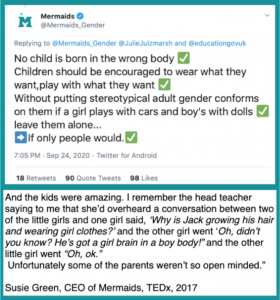
Later they published an article on their website, entitled ‘Do you use the phrase: ‘Born in the wrong body’?
“We recently posted that ‘no child is born in the wrong body’, which is our broad position as a charity….One particular phrase, which has been used for a long time by people, is ‘I was born in the wrong body’. Of course, the phrase is one we’ve used ourselves in the past and, at the time, it seemed helpful.”
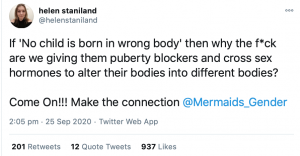
Two days later, Munroe Bergdorf, a patron of Mermaids, made a clumsy attempt at clarification, telling Pink News that “while she had previously described herself as “born in the wrong body”, the 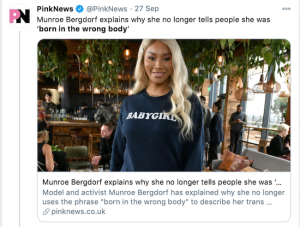 phrase no longer felt like it fit.”
phrase no longer felt like it fit.”
“I know why I used to use it; because other people struggled to understand,” writes Bergdorf. “It’s not the same as saying ‘I need to adjust my body to be my true self’. That’s a different thing.”
The ‘no child is born in the wrong body’ turnaround is in direct contrast to CEO Susie Green’s own comments in the past and also contradicts comments her child, Jackie Green, has made.
“I was born in the body of a boy, but I had the mind and the brain of a girl,” says Jackie in Green’s TedX talk from 2017. “It’s part of my make up. It’s in my DNA. I’m a girl and I always have been.”
That a child can be born in the wrong body is also a belief which can still be found among the parent testimonials on the Mermaids website.
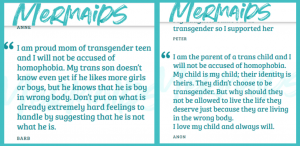
Assigned a gender at birth?
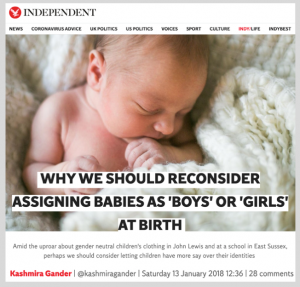 In 2018 the Independent ran an article suggesting we should stop ‘assigning children a gender at birth’. Most of us know that children are not assigned a gender at birth: their sex is observed and recorded, but that didn’t stop the article making this peculiar suggestion:
In 2018 the Independent ran an article suggesting we should stop ‘assigning children a gender at birth’. Most of us know that children are not assigned a gender at birth: their sex is observed and recorded, but that didn’t stop the article making this peculiar suggestion:
“A better system might involve noting down a baby’s sex on medical records, but not in an way that denotes their gender.”
Er… that’s what we do already. The pressure to conform to gender stereotypes comes later. This is a prime example of the doublethink required by gender ideology: we are expected to hold the belief that sex and gender are the same thing at the same time as holding the belief that sex and gender are different things.
Below are the ‘genderbread person‘ and the ‘gender unicorn‘, two ‘cute and friendly’ cartoon characters using posters, worksheets and colouring books to sell kids the idea that we are ‘assigned a sex’ at birth.
“It is important we don’t simply use “sex” because of the vagueness of the definition of sex and its place in transphobia,” warns the gender unicorn.
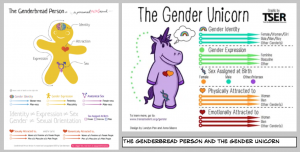
It’s hard to imagine how the belief that babies can be inaccurately ‘assigned a gender’ is not synonymous with the belief that some of them will be born into a body that is ‘wrong’.
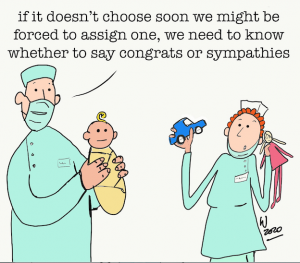
cartoon by @7Wimpund
This idea is not just promoted by trans lobby groups, documentary makers and newspapers; doctors are promoting it too.
In a now infamous video, Doctor Diane Ehrensaft, a San Francisco child psychologist and founding member of the Child and Adolescent Gender Center, tells her audience (at approx 2.06.00) that boy babies may unsnap their babygros to make flowing dresses because they are really girls. Girl babies may pull out their hairslides because they are really boys. There is a short clip here.
“I have a colleague who is transgender.” Ehrensaft tells her audience at an education event in Santa Cruz. “There is a video of him as a toddler- he was assigned female at birth- tearing barrettes out of then-her hair. And throwing them on the ground. And sobbing. That’s a gender message… they can show you what they want to play with… this child wore the little onesies with snap-ups between the legs and at age one this child would unsnap them to make a dress and have the dress flow… this was a child who was assigned male… that’s a pre-verbal communication.”
This insanity was presented at a major events to nods of agreement, laughter and applause.
My body is me
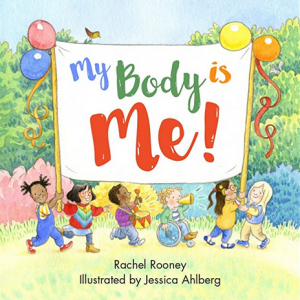
“I am my body, my body is me, it’s a wonderful thing, I’m sure you’ll agree!”
In December 2019, when author Rachel Rooney released her children’s book ‘My Body is Me’, a body positive book published by Transgender Trend, she was bombarded with accusations of hatred, including the suggestion that the book was ‘anti-trans extremism’ equivalent to ‘terrorist propaganda’.
Rooney, reported the Times, “wrote the book to counteract what she described as an explosion of titles that promoted the idea that children who felt confused about their gender may be ‘trapped in the wrong body’.
“It’s impossible to have the ‘wrong’ body. It’s a very worrying message we’re sending to children,” says Rooney.
In 2019, psychotherapist Stella O’Malley told the Independent:
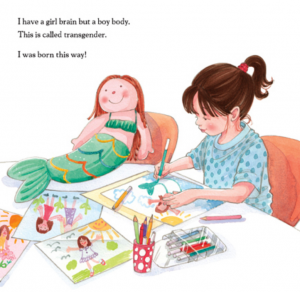
A page from the children’s book ‘I am Jazz’
‘Born in the wrong body’ is a great description of a feeling but it’s not a diagnosis. And psychologically, that is a very dangerous thing to say to somebody.
Can you be born in the wrong body? Can you be born in the wrong head? Are people who are born in very challenging bodies, through disability, are they born in the ‘wrong’ body?
I reject the concept. We’re born in the body we have… I think the underlying concept of being born in the wrong body is troubling. And for somebody who is 14, 15, maybe younger, and feeling distressed, lost, lonely, who feels wrong, and that their body is wrong – that phrase can be hugely appealing.”
receipts
Lest we forget, here are just over a dozen examples of articles, activists and videos telling us that trans people are ‘born in the wrong body’.
The 2015 mini-series ‘Born in the Wrong Body’ (My Transgender Summer Camp / Girls to Men / My Transgender Kid
Jazz Jennings “Ever since I could form coherent thoughts, I knew I was a girl trapped inside a boy’s body. There was never any confusion in my mind.”
YouTube video “born in the wrong body- my transgender kid’
‘This Morning‘ Breakfast television: He said ‘mummy, I’m a boy in a girl’s body’
Transactivist Katy Montgomerie “I was literally born in the wrong body”
Radio Ulster documentary ‘Transgender teens: born in the wrong body’
Vox: ““Many trans people have felt since birth, or at least a very young age, that they were born in the wrong body …”
YouTube video: Growing up trans: “I’m a girl stuck in a boy’s body”
The Telegraph “My child had a boy’s brain in a girl’s body”
Focus: “‘I am a girl trapped inside a boy’s body”
The Metro: Beauty blogger NikkieTutorials ‘I was born in the wrong body’
Daily Mirror article ‘Transgender woman reveals heartbreak of being born in wrong body’
The Guardian: Owen Jones: ‘There is the sense that they are…sufferers of psychological conditions rather than people trapped in the wrong bodies.”

In the wake of astonishment at this classic ‘reverse ferret’, we are now being told that ‘born in the wrong body’ is ‘a metaphor’, that we were never meant to take the idea literally, that it was only used because stupid, unimaginative ‘cis’ people wouldn’t understand otherwise.
“Born in the wrong body is a metaphor to help explain how trans people feel,” tweeted Sapphic Queen (she/her), who also advises that ‘bigots can fuck a cactus’.
“It’s not a literal statement,“ added Trans Goddess Queen of Sex, “it’s only a way of rationalising a feeling, which are always very difficult to put into words without metaphors or analogies.”
““Born in the wrong body” is a metaphor not a fantasy,” agreed Womb Raider, cissie, (she/her)
If this really is the case, why is the idea being pushed to children? Children have problems discerning fantasy from reality at the best of times. If they are being told they might be ‘born in the wrong body’ how can we possibly expect them to interpret it as some kind of metaphysical metaphor?
Autism
It is of especial concern that young people on the autistic spectrum are being led to believe that they could be born in the wrong body, as autistic children frequently show signs of gender dysphoria and are disproportionately represented at gender clinics.
“Between April 2011 and August 2018, 48% of children and young people who were seen in GIDS …scored in the mild to severe range (on the SRS scale)” reported Anna Churcher Clarke and Anastassis Spiliadis of The Tavistock and Portman NHS Foundation Trust. A shocking ten percent of girls scored in the severe range.
Autistic children are known for taking what they are told literally. As parent Lisa Smith writes on her blog, “Figurative language and abstract ideas are a mystery to a child with autism. So, when you say things like, “Pick up the pace” and your other students know you want them to walk faster, my son will be looking for something called “pace” that he should be lifting from the floor.”
No debate
Last year a friend wanted to ask me some questions about gender. We were having a chat and a cup of coffee in my kitchen when he raised the subject. Despite there being no-one else in the house, he lowered his voice and glanced from left to right before speaking.
“I didn’t do that,” he said, uncertainly, when I pointed it out. But he did.
We have been trained to believe that to even consider the harmful absurdity of gender ideology is transphobic. Nobody wants to be considered a bigot. But the cruelty of laughing at or mocking a transexual person on the tube for example, is a very far cry from questioning whether kids should be taught they can change sex.
The ‘born in the wrong body’ narrative has developed partly because we are no longer allowed to tell the truth- that gender dysphoria is a mental illness.
For many years pro-child transition organisations have told us that ‘cis people’ do not understand, that there are indeed pink brains and blue brains, that they can be put into the wrong bodies and even if science can’t prove it it’s probably true, and even if it isn’t literally true we need to say that it is because we need to BE KIND, because if we aren’t kind then children will self-harm and anyway look– little Tomasina is wearing a tutu and little Charlie is doing martial arts.
“No debate!” we are told if we ask questions. “Trans kids lives are not up for debate!”
Because over and again we are told that we must listen, assimilate and accept what we are told, is it any wonder that many people have started to do exactly that?
As a result of this, children are being told, by clinics, lobby groups and even schools that they are ‘assigned a gender’ at birth and that they can identify out of it if they choose to do so.
Gender stereotypes
“Materials which suggest that non-conformity to gender stereotypes should be seen as synonymous with having a different gender identity should not be used and you should not work with external agencies or organisations that produce such material.”
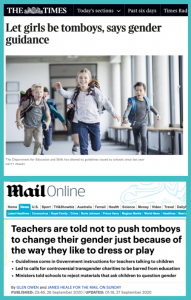 “Let Girls be Tomboys!” announced the Times on Monday, referring to the government guidelines released on 25th September, adding, “The change (in government guidelines) could be a response to advice issued by trans charities, such as Mermaids, which says “trans children will sometimes express part of who they are by choosing particular toys and clothes.”
“Let Girls be Tomboys!” announced the Times on Monday, referring to the government guidelines released on 25th September, adding, “The change (in government guidelines) could be a response to advice issued by trans charities, such as Mermaids, which says “trans children will sometimes express part of who they are by choosing particular toys and clothes.”
The Mail on Sunday also published an article concerning the new government guidelines, and it was to this that Mermaids published a response claiming, “no teacher has ever been encouraged by any LGBTQ+ organisation to state that ‘tomboys’ should be transgender” begins the response.
This seems a strange claim to make. The recording made at a training session where Mermaids trainers told teachers to use the ‘jellybaby’ model to explain ‘gender identity’ has been in the public domain for some time now.
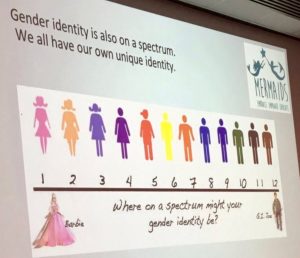
A trainee teacher who attended one such training course told The Spectator ‘in 2018:
“teachers were told that gender is a spectrum and shown a graph with Barbie at one end and GI Joe at the other. They were asked to consider where they and their students would fit on this chart. ‘
Mermaids now claims the slide was “presented at the time by our training team as a tongue-in-cheek, knowingly-over-simplified look at various gender expressions”.
So the presentation was a joke? Another metaphor?
How on earth are we to know what is serious and what is not?
“We are working hard to make room for a sensible, kind, reasonable conversation,” Mermaids now claims, and this too is hard to believe. This is the same organisation that refused to appear in Olly Lambert and Stella O’Malley’s documentary- despite half the documentary consisting of interviews with trans-identified people- claiming Stella was ‘unqualified‘ and ‘confused’. Trans organisations’ refusal to discuss the issue with, or even speak to, Lambert caused him to comment that making the documentary ‘made reporting on the Middle East peace process look straightforward’.
The toy and clothing question
 This is not the first turn around on the part of Mermaids. In July this year it released a piece called ‘the toy and clothing question‘.
This is not the first turn around on the part of Mermaids. In July this year it released a piece called ‘the toy and clothing question‘.
“Children play with all sorts of toys and that doesn’t mean for a second they’re transgender. The same goes – of course – for clothing.”
The article goes on to show quotes from parents who said their trans-identified child did not show a penchant for the toys or clothes usually associated with the opposite sex, including this:
“My daughter is a jeans-wearing, skateboarding trans girl. For her, being trans is nothing to do with wearing dresses or playing with dolls, it’s who she is deep down inside.”
This might have come as a surprise for those who have read previous parent testimonies on the Mermaids website which include the following:
‘he would never wear girls’ knickers… the first words he wrote were Mr’ and ‘he’… he was never a girly girl… when I insisted he wear a dress he became hysterical… she always wanted to be a princess… she always wanted long hair too… (she) loved bracelets and constantly wanted to wear one…”
A Mermaids ‘factsheet’ for professionals states ‘Children are known to be aware of their gender from the age of 4 or 5, others even before that age may reach instinctively for the toys of the opposite gender.”
Children’s choices
Once again , this is a line that we’ve been fed for the last decade: that it’s the clothing, toy and hobby choices of children that makes them transgender.
In my 2017 article ‘Trans-identified kids and the Media‘ I listed a score of newspaper and magazine articles where a child’s choice of toys, hobbies and clothing are cited as the very things that mark them out as being transgender.
Some reasons included:
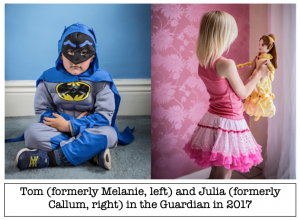 Asking for pink outfits, liking mermaids, choosing a pink bike, drawing pictures of princesses, liking My Little Pony, wanting painted nails, wanting to wear make-up.
Asking for pink outfits, liking mermaids, choosing a pink bike, drawing pictures of princesses, liking My Little Pony, wanting painted nails, wanting to wear make-up.
Liking ET and hating Frozen, wearing a tie to church, not liking pretty braids, liking cars and dinosaurs, wanting to play basketball, not wanting to wear make-up.
Can you guess which preferences belonged to which group of trans-identified children?
‘Trans’ children, so the story has always run, can be identified through their choice of toys, clothing and hobbies. This seems pretty obvious. After all, if it wasn’t these choices that made them trans, what could it possibly be?
The idea is, of course, astonishingly sexist and bears little scrutiny. After all, if certain toys are for boys and others for girls, why not go further and say the same about sports, or even jobs?
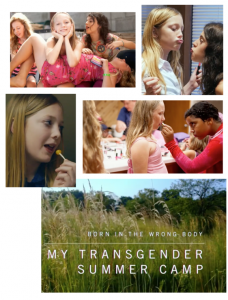 Of course, nobody claimed that all girls who liked football were boys, or that all boys who liked Barbies were girls, but in media reports on every trans child, the child’s parents would list the clothing, toys and hobbies more usually associated with the opposite sex as if this were somehow proof of their child being… well… born in the wrong body. And in recent times, with the growing trend for trans-identified kids, it’s quite likely that the mum of an effeminate little boy will be asked by well meaning teachers and friends ‘do you think he might be trans?’.
Of course, nobody claimed that all girls who liked football were boys, or that all boys who liked Barbies were girls, but in media reports on every trans child, the child’s parents would list the clothing, toys and hobbies more usually associated with the opposite sex as if this were somehow proof of their child being… well… born in the wrong body. And in recent times, with the growing trend for trans-identified kids, it’s quite likely that the mum of an effeminate little boy will be asked by well meaning teachers and friends ‘do you think he might be trans?’.
Remember the little boys of American documentary ‘My Transgender Summer Camp’ with their lipstick, lollipops and flowing hair? Some might remember the subtitle of that documentary. For those that don’t, it was ‘born in the wrong body’.
There are also books telling children that it IS their toy and clothing preferences that make them boys or girls.
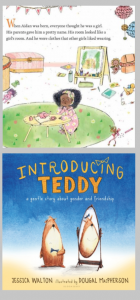 In ‘When Aiden became a Brother‘ the reader is told “When Aiden was born, everyone thought he was a girl. His parents gave him a pretty name. His room looked like a girl’s room. And he wore clothes that other girls liked wearing.”
In ‘When Aiden became a Brother‘ the reader is told “When Aiden was born, everyone thought he was a girl. His parents gave him a pretty name. His room looked like a girl’s room. And he wore clothes that other girls liked wearing.”
In ”Introducing Teddy‘ Tilly the teddy tells his friend that he has always felt he was a girl. How is this expressed? As we can see on the cover, Tilly decides to wear his bowtie as a bow on top of his head. Teachers’ notes for the book suggest that trans children ‘might decide to wear different clothes or change their hair if that’s what makes them happy’.
We often revert to talking about clothes and toys simply because it’s easier for other people to understand,” writes CEO Susie Green, in ‘the toys and clothing question’.
“Hopefully this blog has helped to make things a little clearer for those confused about the question of toys, clothes and trans identity… we do not suggest that toy and clothing choices are a sole or primary signifier of a child’s gender identity. However, like any child, trans children will sometimes express part of who they are by choosing particular toys and clothes. ”
Well, no, actually. It’s made things a hell of a lot more confusing actually. If your child’s clothing, toy and hobby choices have nothing to do with them being trans, then what does?
If transkids aren’t born in the wrong body and being trans isn’t about clothing, toy or hobby choices, how do we know when a kid is trans?
A Mermaids spokesman told The Mail on Sunday,“We accept this point requires careful and subtle expression and we’re working hard to improve the clarity of our messaging.”
Remember the skateboarding, jeans wearing transgirl? Another parent on the Mermaids website, rejecting the ‘born in the wrong body’ and ‘toys, clothes and hobby‘ options wrote:
“My son told me he was trans so that was the signifier, really, nothing more than that.”
So the message from Mermaids now seems to be this. Please correct me if I’m wrong.
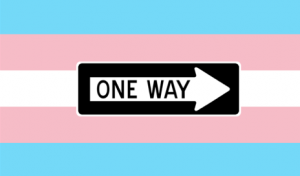 You can’t tell if a child is trans because of their toy or clothing choices, or because of the hobbies they choose, but if a child says they are trans everyone around them should affirm the idea. Anyone who doesn’t affirm a child who says they are trans is transphobic.
You can’t tell if a child is trans because of their toy or clothing choices, or because of the hobbies they choose, but if a child says they are trans everyone around them should affirm the idea. Anyone who doesn’t affirm a child who says they are trans is transphobic.
This seems crazy. We are talking about the fantasy world of troubled children here.
Surely Mermaids- who recently ran a training session teaching that children as young as twelve should be offered ‘totally reversible’ hormones to block puberty– aren’t now suggesting the only way to tell if a child is transgender is if they tell you so?
Like many of us, Twitter user Marion felt ‘a little confused’ by the recent statement and tweeted at Mermaids asking for clarification.
“If Mermaids are stating that no child is born in the wrong body and children can wear whatever they like and choose any toy they like,” she asked, how do Mermaids know that a child is trans?
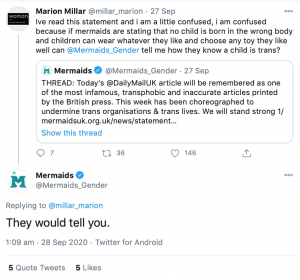
“They would tell you.” replied Mermaids.
Oh.
Puberty blockers and cross-sex hormones all round it is, then!

Remember the Freethinker Vs Fundamentalist on-line battles of about ten years ago? For a while, the Fundamentalists were winning then something happened and the Freethinkers took the high ground and the Fundamentalists saw this and began to panic and make alarming accusations as they lost ground more and more neutrals were seeing what was happening? A grudging armistice was signed and both groups faded away but the Freethinkers had shown up the Fundamentalists as anti-science? It’s what is happening now.
Only it’s the Trans Rights Activists Vs the Radical feminists and the Trans Rights Activists are seeing defeat and a resorting to flinging insults and making denials while the Radical Feminists are looking more reasonable and grounded.
Wonderful evidence-based overview of this saga. Thank you so much for doing this important work.
Mermaids can’t run faster than prosecutors eventually will.
“They will tell you.”
And if a child has never heard the word ‘trans’, there will be nothing to tell you.
This article doesn’t really make any sense. It quotes Mermaids saying that no one is “born in the wrong body” and then provides extensive quotes that are mostly from other organizations and people.
The hyperfocus on gender roles in trans kids by news is a pretty frequent point of discussion and criticism within the trans community. It is odd to criticize the trans movement for something that news media are doing, especially when those news media are being criticized as transphobic by the trans movement for the very same reasons you list.
As for the mentioning of it at all, I don’t see it as very different from most people mentioning the same factors in their childhood. We live in a culture that’s fairly soaked in gender roles. Toy marketing is just one example of something that’s heavily gendered. If girls trend towards playing with dolls and wearing dresses, and boys towards playing with cars and finding wearing skirts embarrassing, then that shouldn’t be taken as confirmation that gender roles are innate. It should be seen as an example of how we are influenced by gendered messages in society. None of that really changes when it’s trans people. The criticism would be better placed with the news media than with trans people just straight up saying what toys they played with as a kid.
The problem is that trans organizations have successfully lobbied governments and institutions with their cult like ideology. They aren’t necessarily even representative of most people who think they are trans. Because of their misogynist, patriarchal , corporatist ideology, and billionaire funding, they have corrupted our government and institutions. It’s a regressive, anti-democratic, divisive, ideology that has negatively impacted our ability to organize politically, and it is endangering the lives of a generation of children.
Pingback: The Irreconcilable Conflict Between Feminism and Gender Identity – Voyage of the Dusk Treader
I am having a hard time even accepting that there is such a thing as “trans”, particularly in children. If the scientific reality is that no one can be” born in the wrong body”, and it doesn’t really matter what toys, clothes or preferences children have, where is this idea of trans even coming from? Isn’t “transgender” the re-word for “transsexual” who is/was a person who underwent extreme physical and hormonal measures to “become” the opposite sex/gender? There were always kids who seemed more like the opposite sex/gender than what they were but mostly that was just personal preference and not necessarily a sign that they believed, or that anyone believed that they were not really the sex/gender they were born. I have a feeling that, like everything else that tends to be in vogue, or on trend, or clogging up the social media outlets, being “trans” is a “thing”, and if a person (mostly younger or teens, who are majorly exposed to and motivated by such media) has any doubts about his or her “identity” or “sexual orientation”, he or she is labeled “trans”. Someone somewhere who knows labels them “trans”, or suggests that they may be “trans”. And that is that, and everyone else goes along. And they go along, because it is sure an easy way out of the misery they may be feeling. But mostly these would be kids who are struggling with some deep psychological self-doubt and really need some therapy – but because being “trans” is a completely logical “thing”, even normal and on the rise as it seems to be far more interesting than just being a plain old boy or girl, no worries, these kids are unlikely to get the help they really, sometimes desperately, need. They will go along if everyone else is going along, how could so many people be wrong about them? But what if they go for it, all the way, and then they are still distressed and confused? Why didn’t anyone tell them that no one is “born in the wrong body” or that “trans” is just a term used to define someone who is non-conforming but still acceptable and has good qualities and a lot to offer the rest of the world?
I’m glad to see this article putting some of my thoughts out there and pointing out some of the realities that a lot of people and organizations have been overlooking because it is the politically correct thing to do, at the expense and demise of many children and young adults. What a shame, shame on them!
Pingback: The Feminist library open letter & how it went terribly wrong -Lily Maynard
Pingback: At Last, Mainstream Journalists Are Starting to Report the Truth About Youth Gender Clinics – La Linterna Azul